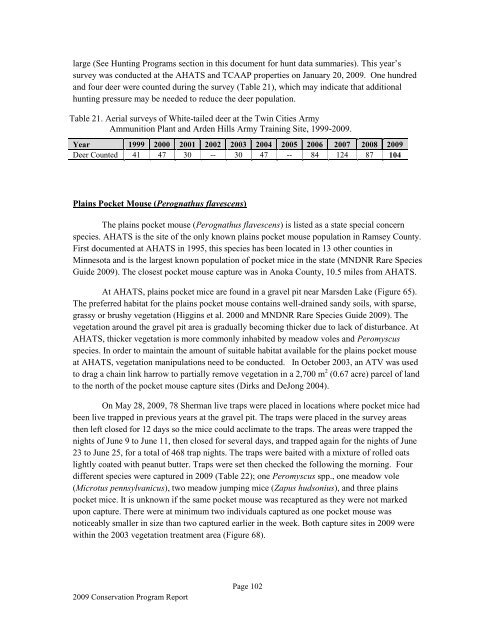camp ripley and arden hills minnesota army national guard training ...
camp ripley and arden hills minnesota army national guard training ...
camp ripley and arden hills minnesota army national guard training ...
Create successful ePaper yourself
Turn your PDF publications into a flip-book with our unique Google optimized e-Paper software.
large (See Hunting Programs section in this document for hunt data summaries). This year‟s<br />
survey was conducted at the AHATS <strong>and</strong> TCAAP properties on January 20, 2009. One hundred<br />
<strong>and</strong> four deer were counted during the survey (Table 21), which may indicate that additional<br />
hunting pressure may be needed to reduce the deer population.<br />
Table 21. Aerial surveys of White-tailed deer at the Twin Cities Army<br />
Ammunition Plant <strong>and</strong> Arden Hills Army Training Site, 1999-2009.<br />
Year 1999 2000 2001 2002 2003 2004 2005 2006 2007 2008 2009<br />
Deer Counted 41 47 30 -- 30 47 -- 84 124 87 104<br />
Plains Pocket Mouse (Perognathus flavescens)<br />
The plains pocket mouse (Perognathus flavescens) is listed as a state special concern<br />
species. AHATS is the site of the only known plains pocket mouse population in Ramsey County.<br />
First documented at AHATS in 1995, this species has been located in 13 other counties in<br />
Minnesota <strong>and</strong> is the largest known population of pocket mice in the state (MNDNR Rare Species<br />
Guide 2009). The closest pocket mouse capture was in Anoka County, 10.5 miles from AHATS.<br />
At AHATS, plains pocket mice are found in a gravel pit near Marsden Lake (Figure 65).<br />
The preferred habitat for the plains pocket mouse contains well-drained s<strong>and</strong>y soils, with sparse,<br />
grassy or brushy vegetation (Higgins et al. 2000 <strong>and</strong> MNDNR Rare Species Guide 2009). The<br />
vegetation around the gravel pit area is gradually becoming thicker due to lack of disturbance. At<br />
AHATS, thicker vegetation is more commonly inhabited by meadow voles <strong>and</strong> Peromyscus<br />
species. In order to maintain the amount of suitable habitat available for the plains pocket mouse<br />
at AHATS, vegetation manipulations need to be conducted. In October 2003, an ATV was used<br />
to drag a chain link harrow to partially remove vegetation in a 2,700 m 2 (0.67 acre) parcel of l<strong>and</strong><br />
to the north of the pocket mouse capture sites (Dirks <strong>and</strong> DeJong 2004).<br />
On May 28, 2009, 78 Sherman live traps were placed in locations where pocket mice had<br />
been live trapped in previous years at the gravel pit. The traps were placed in the survey areas<br />
then left closed for 12 days so the mice could acclimate to the traps. The areas were trapped the<br />
nights of June 9 to June 11, then closed for several days, <strong>and</strong> trapped again for the nights of June<br />
23 to June 25, for a total of 468 trap nights. The traps were baited with a mixture of rolled oats<br />
lightly coated with peanut butter. Traps were set then checked the following the morning. Four<br />
different species were captured in 2009 (Table 22); one Peromyscus spp., one meadow vole<br />
(Microtus pennsylvanicus), two meadow jumping mice (Zapus hudsonius), <strong>and</strong> three plains<br />
pocket mice. It is unknown if the same pocket mouse was recaptured as they were not marked<br />
upon capture. There were at minimum two individuals captured as one pocket mouse was<br />
noticeably smaller in size than two captured earlier in the week. Both capture sites in 2009 were<br />
within the 2003 vegetation treatment area (Figure 68).<br />
2009 Conservation Program Report<br />
Page 102
















